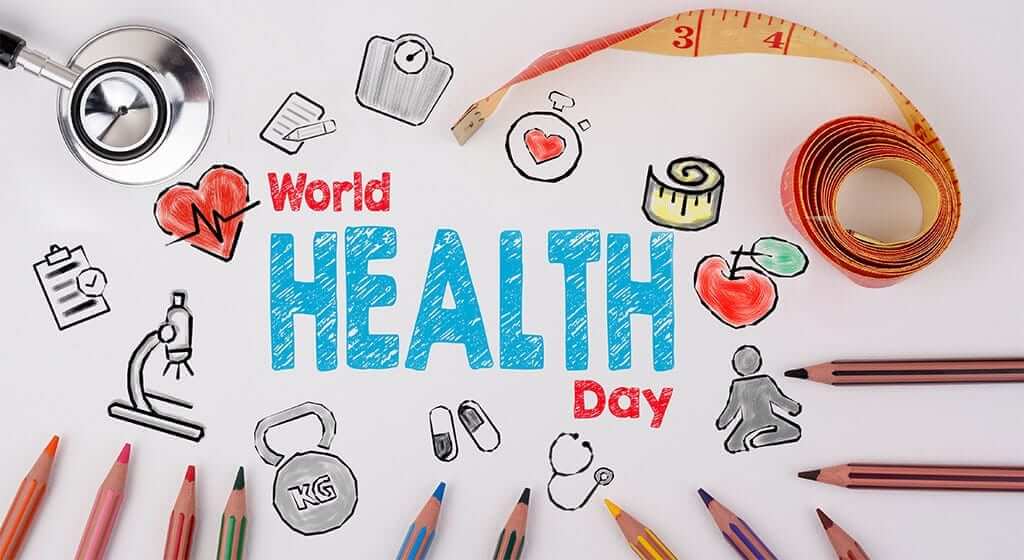April 7,2018 will be the 70th anniversary of World Health Day which was first initiated in 1948. With sponsorship from the World Health Organization (WHO), there is promotion of all life stages improving access to care especially in developing countries. They try to achieve internationally agreed upon goals to promote improved health in all aspects of disease. World health leaders “commit to concrete steps to advance health care for all.” Everyone, everywhere, should be able to obtain health care without financial hardship, yet 1/2 the world still lacks access. Although WHO deals with a huge array of diseases, one of the missions of the World Health Organization is “to prevent type 2 diabetes, minimize diabetes complications and maximize the quality of life for all people with diabetes.”
According to the World Health Day website, “422 million adults will have diabetes worldwide by 2030 and 1.6 million will die annually, directly attributed to cardiovascular disease.” One in three adults over age 18 worldwide are considered overweight and one in ten adults worldwide is considered obese, possibly leading to diabetes. The WHO overview for diabetes is that it may be life-threatening, is very common and is dramatically rising around the world even in non-industrialized societies. WHO maintains you can live a full and healthy life with diabetes if treated correctly and in many cases, may even be prevented. Although we in the United States are blessed to have mostly excellent access to medical care, there are those here with limited access, diabetes still accounts for 25% of yearly emergency room visits. Every year in the US, the American Diabetes Association updates the guidelines for Standards of Care in Diabetes. “The standards of care are the primary resource for the optimal management of diabetes in the US and include updated guidelines for diabetes diagnosis and for evidence-based prevention of diabetes and diabetes related complications.” Let’s examine some of the 2018 ADA Standard guideline updates below to improve the overall care of diabetes, at least in the US.
- A1C: Keep 7% or lower as an A1C goal except for young, healthy, newly diagnosed people who should focus on an A1C of 6.5% or lower. A1C values should be individualized for everyone especially the elderly and those who have existing heart disease or other diabetes complications. Understand that A1C may have limitations for sickle cell anemia, other types of anemia and any red blood cell turnover diseases.
- CGM: Expand the use of continuous glucose monitoring (CGM) in all patients with type 1 diabetes who are 18 and older who have not met reasonable glycemic targets. There are no pediatric guideline updates yet. Some CGM devices may be able to replace finger sticks.
- Children and Adolescents: New guidelines for screening for pre-diabetes and diabetes in children and adolescents. No change in guidelines for adults and the elderly.
- Medication and Pharmacology Therapy: Medications should be looked at individually to prevent the risk of hypoglycemia or over treatment in anyone with diabetes. Over treatment is very common in the elderly.
- Cardiac Disease: More attention and concern will be focused on complications of cardiovascular disease since it is a leading cause of death in those with diabetes. Use of diabetes medications which will protect and target heart function in diabetes patients.
- Medication Risks: More attention will be given to diabetes medications and its effect on weight gain, kidney function and costs.
- Blood Pressure: Although the American Heart Association changed blood pressure guidelines to 140/80 designating hypertension, the ADA maintains hypertension as 140/90 due to study evidence with diabetes and will be considered differently for selected patients. ADA would encourage patients to test blood pressure at home to avoid over treatment from “white coat syndrome”, a condition where the blood pressure elevates as the physician’s office with no medical reason.
- Insulin: Insulin should never be prescribed as a threat or punishment but as an alternative when other diabetes medications are not reaching goal targets. Insulin can be given in different ways such as basal/bolus through an insulin pump or in different tools like insulin syringes or pen injections and should be individualized.
- Metformin: Metformin remains the “foundation drug for treatment of type 2 diabetes.”
- Lifestyle: Lifestyle should be included as one aspect of diabetes care for all patients with diabetes.
What does this all mean for someone in the US near World Health Day who has diabetes? Guidelines are available and should be provided to you, the patient, to achieve adequate diabetes control. Diabetes management is real and can be found in all regions of the US, and should be used to help manage your disease. What does diabetes management entail?
Your Diabetes Management Team

Self-Body Scan
Nothing is more effective than a daily self-body scan. Quickly scan your body after a bath or shower. Check all skin surfaces, include under breasts, under arms and in skin-folds where fungus often develops due to heavy perspiration and elevated blood sugars. Check the soles of your feet and in-between toes. If you can’t reach or see the soles of your feet, use a long handle mirror. After your shower or bath, moisturize with a white, non-fragrant cream or lotion since diabetes raises the risk of dry, flaky, cracked skin. Use corn starch powder in places where perspiration occurs. Treat only simple scrapes and cuts by washing with warm water and soap, then cover after using antibiotic gel. Do not self treat anything but a small, superficial wound. If your injury is not healing within 24 hours, seek medical help. People with diabetes are at risk for infections especially when blood sugars are high. Only clip toenails if you are easily able to and be sure to clip straight across and file down the rough edges. Otherwise, schedule a visit to the podiatrist.
Shoe Selection
Have an indoor and outdoor shoe selection available. Look for shoes made from leather, canvas or any product that is not man-made for better foot protection and comfort. Never go barefoot for risk of injury. People with diabetes often have circulation and nerve ending problems in their feet. Keep soft slippers by your bed, rubber pool shoes for water activities and well fitted and supportive shoes for outside. Wear diabetic socks or blended socks with natural and synthetic fibers to protect feet from rubbing and fungus formation from excess perspiration. Change shoes frequently so they can “air out” and dry which will also decrease the risk of fungal infections. Avoid shoes with a narrow toe box or high heels.
Be Ready for an Emergency

Blood Sugar Checks
Check blood glucose levels with a glucose monitor daily or as directed by your health care provider. Your health care provider will decide when and how often you should use a glucose meter based on your current A1C, previous highs and lows, your current diabetes medication and activity levels. Your glucose meter should not be left in a car due to excessive heat or cold or in the bathroom due to high humidity. The glucose testing strips should be specific to your meter and in date, otherwise you will get an inaccurate result. Keep glucose testing strips in their original container until you are ready to use them to preserve freshness. Make sure the strips have not expired. Use control solution when starting a new vial of strips to check for accuracy. According to the ADA, blood sugars should be between 80-130mg/dl when fasting and less than 180mg/dl 2 hours after a meal. Discuss with your physician what your numbers should be. Consider writing your results in a logbook or document on a spreadsheet. Smart devices can keep number logs and help watch trends. The most common times for testing blood sugars are: fasting in the morning, 2 hours after a meal, at bedtime, when starting a new diabetes medication, when you are sick and before or after exercise.
Insulin
If you take insulin to control your diabetes, understand “it is not to punish you for bad behavior but to help you get diabetes control.” There are different types of insulin available to make life more convenient and you and your health care provider will decide which works best for you, depending on your schedule. There is rapid acting insulin, taken prior to meals called “bolus” and long acting insulin taken either in the morning or night or both called “basal” insulin. Make sure to always have an adequate supply of insulin syringes to inject your insulin. Insulin syringes can be used with extra short needles or longer needles depending on your preference. Insulin is injected into the subcutaneous or fat layer and does not require a long needle. Check with your health care provider to decide what needle length you require. There are also insulin pens which hold the insulin cartridge and require the use of pen needles. Dispose of and change your insulin syringes or pen needles after each use, “for the cleanest stick” since they are thin and become dull quickly. A new needle will cause less pain and offer less chance of an infection. A reused needle will cause more bleeding, be painful, and cause more lumps and bumps. Blood sugars go down after bolus insulin, so make sure to eat.
Eating Plan

Exercise or at Least Exercise in Spurts
Yes, it is wonderful if you have 30-60 minutes allotted for daily exercise but if you do not have that luxury then incorporate spurts of exercise to keep moving. Research confirms, “any movement is good for you.” Walk, bike, spin, hike, play tennis, take dance, skate, ski, walk the dog, swim, mow the lawn, shovel the snow, wash the car, take yoga, Pilates, boxing or lift weights. Find your passion and mix it up. Add balance exercises and stretching. Exercise will help your heart, blood pressure, cholesterol and blood sugar.
No Smoking
If you do not smoke, do not start and if you do smoke, find a way to quit. Find help, it is an addiction.
Sick Day Kit/First Aid Kit
Accidents happen but only treat minor injuries. Have sterile gauze, eye drops, Band-Aids, antibiotic cream, hydrocortisone cream and an analgesic. Sick days from an infection may make blood sugars soar so have extra diabetes test strips. You will need to test more frequently. Keep extra batteries for your glucose meter. Have sugar-free jello, low sodium broth, sugar-free throat and cough drops, sugar-free cough syrup and Tylenol for fever. Buy a thermometer to check your temperature. Call your physician, if blood sugars run below 70mg/dl or above 200 mg/dl for 2 days straight. Make sure to get necessary treatment to avoid additional problems and complications.
Wear “Alert ID”
Purchase and wear a medical identification necklace or bracelet to identify you in an emergency. Keep a list of your medications including the names and amounts you are taking, list all medical conditions, and include emergency phone numbers available in your wallet and in the glove compartment of your vehicle. It may just save your life.
World Health Day is here and it should remind us how lucky we are to have so many resources in the United State to help manage our health including diabetes. The choice is up to you!
Have a question or comment? Then post below, no registration required. I would love to hear from you!
NOTE: Consult your Doctor first to make sure my recommendations fit your special health needs.







Leave A Comment